18 Best Indoor Hanging Plants to Elevate Your Home Oasis
If you want to add some greenery to your living space without taking up too much floor space, this guide to the best indoor hanging plants will give you some great options. These plants offer many benefits, from purifying the air to boosting moods and adding a lushness to your indoor space. In this list, you’ll find a carefully curated selection of the best indoor hanging plants that are visually appealing, low-maintenance, and easy to care for. And it’s not a boring list, we have a few plants in this list you probably wouldn’t consider hanging plants, but rest assured they will blow your socks off when fully grown.

Indoor hanging plants offer a unique and space-efficient way to bring greenery’s lush beauty and benefits into any home. It is ideal for those who want indoor plants’ air-purifying, mood-enhancing, and aesthetic advantages but need more floor or shelf space. You effectively utilize underused vertical space by hanging plants from ceilings or wall mounts, allowing for a greener interior without sacrificing valuable floor area.
This approach adds a touch of natural elegance to any room. It also contributes to a healthier indoor atmosphere by adding indoor plants that clean the air and increase oxygen levels.
1. Baby’s Tears
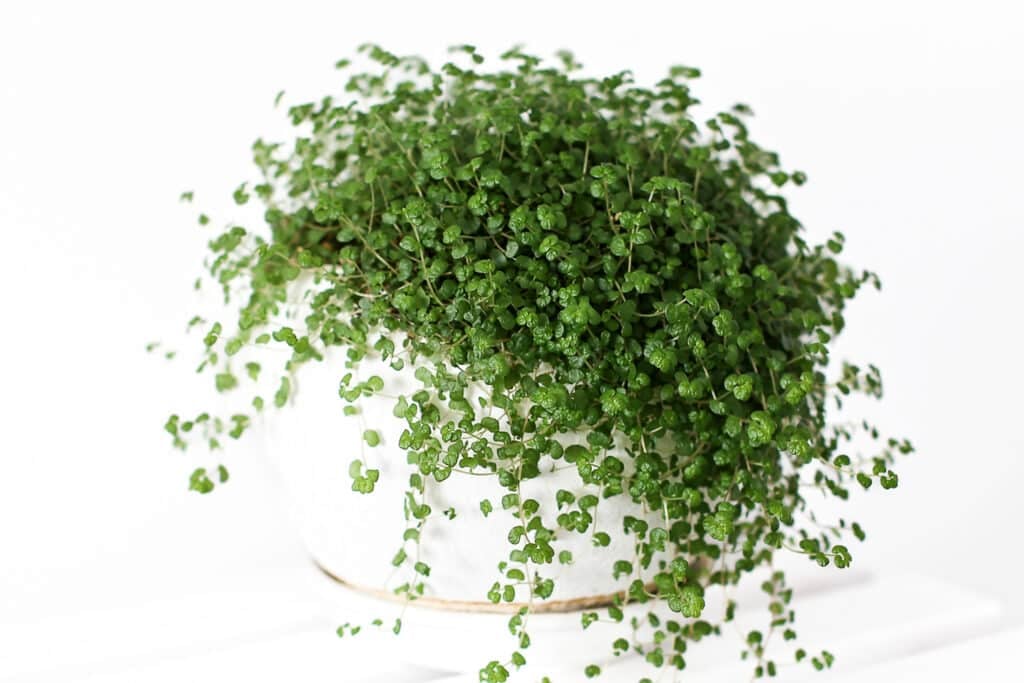
Baby’s Tears, or Soleirolia soleirolii, is a delicate and charming hanging plant that adds a pretty touch to any indoor space.
- Low Maintenance: This plant thrives in indirect light and consistently moist soil, making it an excellent choice for busy individuals or those who claim to have a black thumb.
- Air Purification: Like many indoor plants, Baby’s Tears contributes to air purification by removing toxins and impurities. According to a robust study by NASA, indoor plants can help remove up to 87% of air pollutants in just 24 hours.
- Versatile Aesthetic Appeal: Its tiny leaves cascade down elegantly, creating a lush green curtain that complements various interior design styles. This plant adds visual interest and natural beauty, whether placed in hanging baskets or on high shelves.
- Propagation: Baby’s Tears are easy to propagate through stem cuttings.
2. Spider Plant
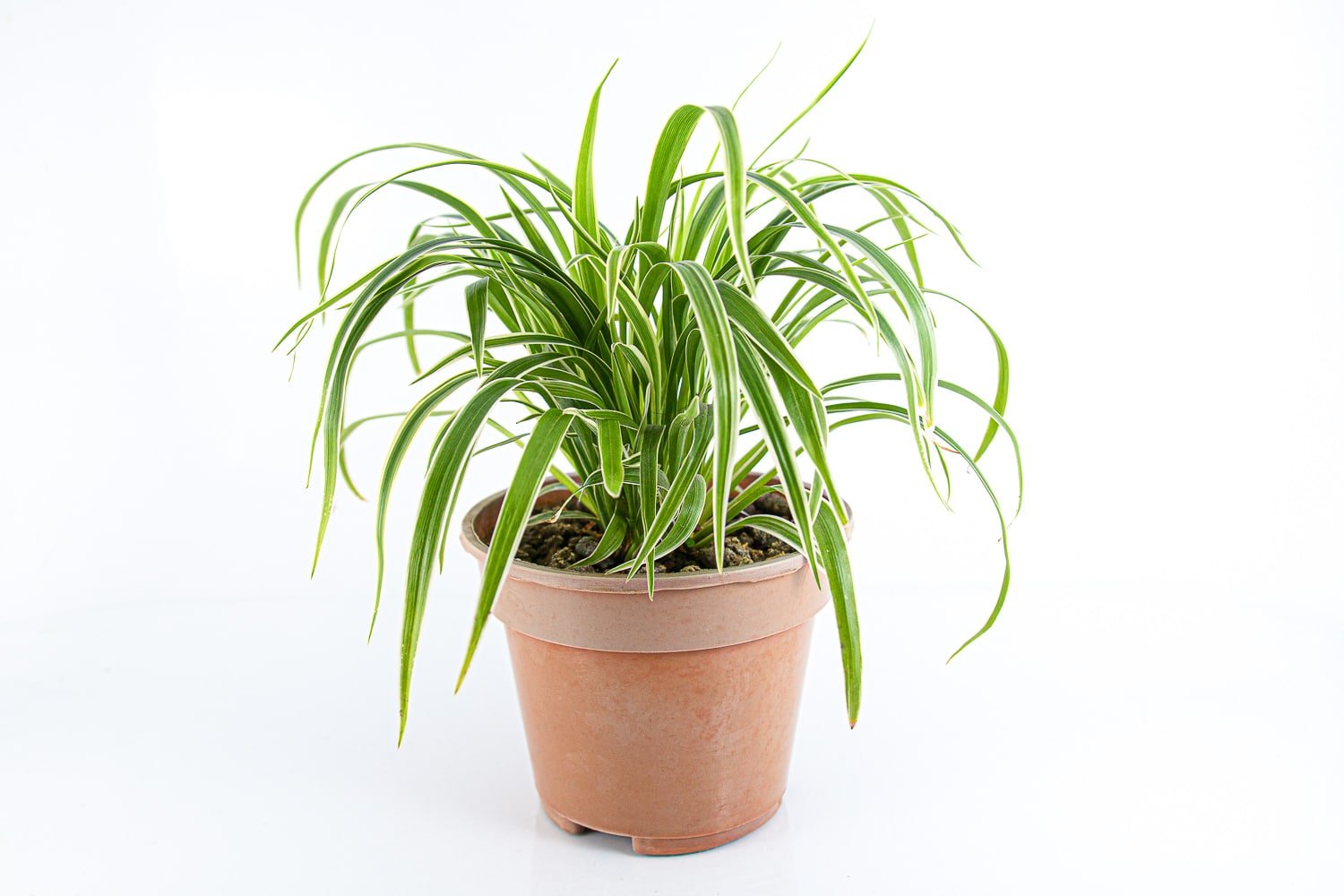
The spider plant, Chlorophytum comosum, is an excellent choice for indoor hanging plants due to its air-purifying qualities and low maintenance requirements. Here’s why the spider plant stands out:
- Air Purification: Spider plants are highly effective at removing toxins such as formaldehyde and xylene from the air, making them a valuable addition to any indoor space.
- Low Maintenance: Spider plants are resilient and adaptable, thriving in various low-light conditions.
- Propagation: One of the fascinating aspects of spider plants is their ability to produce “siderites,” which are small offshoots that can be easily propagated into new plants. This feature makes them ideal for effortlessly sharing with friends or expanding your indoor garden.
- Aesthetic Appeal: With its long, arching leaves and propensity for producing delicate white flowers, the spider plant adds a touch of loveliness to any room.
Spider plants have been proven in numerous studies to enhance indoor air quality by reducing harmful volatile organic compounds (VOCs). NASA’s Clean Air Study identified the spider plant as one of the top air-purifying houseplants. Its adaptability and easy propagation make it an accessible option for both seasoned gardeners and beginners alike.
3. Arrowhead Vine
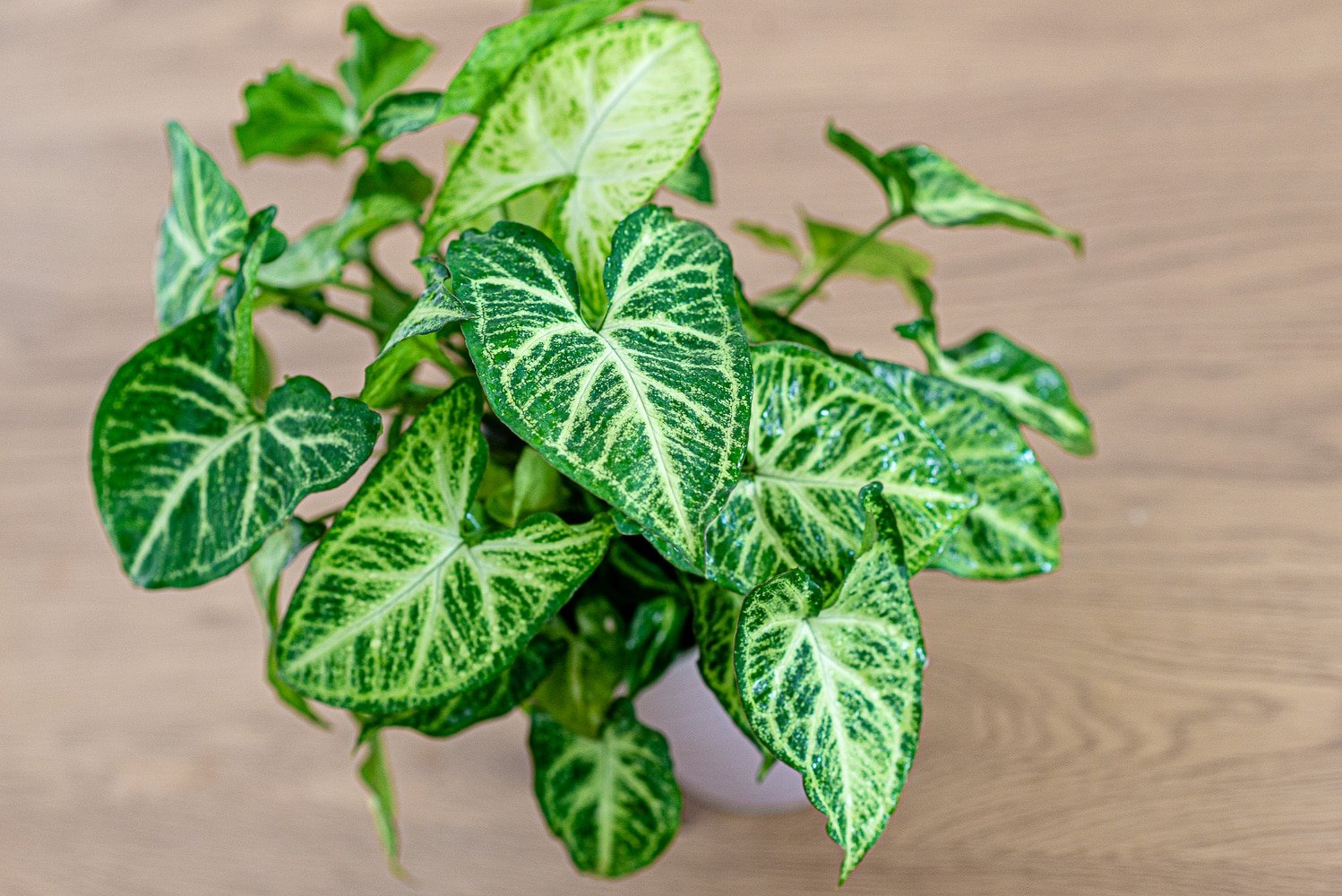
Arrowhead vine, or Syngonium podophyllum, is popular for indoor hanging plants due to its attractive arrow-shaped leaves and low maintenance requirements.
- Adaptability: This plant thrives in various light conditions, making it suitable for different areas within a home. Arrowhead vines can tolerate low-light situations but prefer bright, indirect sunlight.
- Air Purification: Like many other houseplants, the arrowhead vine contributes to air purification by removing pollutants such as formaldehyde and benzene from the home.
- Growth Potential: This plant can grow quickly and may require regular pruning to maintain its desired size and shape. Its growth pattern makes it an excellent option for creating lush hanging displays.
- Variety of Cultivars: The arrowhead vine comes in several cultivars with varying leaf colors and patterns, offering choices such as green foliage or variegated leaves with hues of pink or white.
- Care Considerations: While relatively easy to care for, keeping this plant away from direct sunlight is essential to prevent leaf scorching. Maintaining consistent moisture levels is crucial for its development.
4. Bird’s Nest Fern

The Bird’s Nest Fern is popular for indoor hanging plants due to its unique appearance and low maintenance requirements.
- Unique Aesthetic: The wavy, ripple-edged fronds of the Bird’s Nest Fern add an elegant touch to any indoor space. Its lush green foliage creates a tropical ambiance, making it a visually appealing addition to home decor.
- Low Light Tolerance: Unlike many other ferns, the Bird’s Nest Fern can thrive in low light conditions, making it suitable for areas with minimal natural light. This adaptability makes it an excellent option for rooms with few windows or spaces without direct sunlight.
- Humidity Adaptation: These ferns are well-suited for bathrooms or kitchens as they thrive in high-humidity environments. Their ability to tolerate fluctuating moisture levels makes them versatile choices for various indoor settings.
- Air Purification: Like other houseplants, the Bird’s Nest Fern contributes to air purification by removing toxins and impurities from the surrounding environment. This feature enhances indoor air quality and promotes better respiratory health.
5. Pothos

Pothos, also known as devil’s ivy, is a trendy indoor hanging plant for several reasons:
- Low Maintenance: Pothos requires minimal care, and we mean minimal. If you need to remember to water your plants often, this is the plant for you.
- Air Purification: This plant is adept at removing toxins and pollutants such as benzene from the home, promoting a healthier indoor environment.
- Versatility: It thrives in various lighting conditions, including low light, and can be grown in water or soil.
- Aesthetic Appeal: Its cascading vines add a touch of elegance to any indoor space.
With its adaptability and numerous health benefits, pothos is an ideal plant choice for anyone seeking an attractive yet low-maintenance indoor hanging plant option.
6. Philodendron

Philodendrons may not be the type of plant you think of when you think of a hanging indoor plant, but they actually fill out their planters well and look quite stunning hanging in the corner of a room.
- Air Purification: Philodendrons are excellent air purifiers, removing toxins such as formaldehyde, making them a great choice for improving indoor air quality.
- Low Light Tolerance: They thrive in low light conditions, making them suitable for rooms with low natural light, such as offices or bathrooms.
- Variety of Options: With over 400 species, philodendrons offer a wide range of options. This species list includes heartleaf philodendron, velvet leaf philodendron, and the popular selloum variety.
- Easy Propagation: These plants can be easily propagated by stem cuttings in water or soil.
- Versatile Placement: Their trailing vines make them perfect for hanging planters or placing them on high shelves where their foliage cascades down elegantly.
Philodendrons are not without drawbacks:
- Toxicity: While they’re safe when kept out of reach of pets and children, some species can be toxic if ingested.
7. Chenille Plant

The Chenille plant, also known as Acalypha hispida, is a stunning indoor hanging plant that adds a touch of whimsy to any space. Here are some key insights into this beautiful houseplant:
- Unique Appearance: The Chenille plant stands out with its long, fuzzy crimson blooms that resemble caterpillars or tassels, making it an eye-catching addition to your indoor garden.
- Low Maintenance: This plant thrives in bright, indirect light and requires regular watering. However, it should be allowed to dry out between waterings to prevent overwatering slightly.
- Air-Purifying Qualities: Like many other indoor plants, the Chenille plant improves air quality by removing toxins and increasing oxygen levels indoors.
- Ideal for Hanging Baskets: Due to its cascading growth habit, the Chenille plant is perfect for hanging baskets or elevated containers where its unique blooms can dangle freely.
- Popular Decor Choice: With its visually striking appearance and easy care requirements, the Chenille plant has become famous for interior decorators looking to add color and texture to their designs.
8. String of Pearls

The String of Pearls plant, also known as Senecio Rowleyanus, is a unique and visually stunning hanging plant that adds elegance to any indoor space. Here are some insights into this beautiful plant:
- Distinctive Appearance: The String of Pearls features long cascading stems adorned with spherical, bead-like leaves that closely resemble a string of green pearls. This unique appearance makes it an eye-catching addition to hanging baskets or elevated shelves.
- Low Maintenance: This succulent plant is highly resilient and requires minimal care. It thrives in well-draining soil and prefers bright but indirect sunlight.
- Air Purification: Like many other succulents, the String of Pearls has air-purifying qualities. It can help improve indoor oxygen quality by removing toxins such as formaldehyde and benzene.
- Propagation: One interesting aspect of the String of Pearls is its ease of propagation. With proper care, individual beads on the stems can take root in soil or water, allowing for effortless expansion of your plant collection or thoughtful gifting to friends and family.
- Potential Toxicity: While this plant’s unique appearance is captivating, it’s essential to note that the String of Pearls is toxic if ingested by pets or humans. Therefore, you should place it out of reach of curious pets or young children.
9. String of Hearts

The String of Hearts, also known as Ceropegia woodii, is an elegant trailing plant with heart-shaped leaves that make it a perfect addition to any indoor space.
- Low Maintenance: This lovely plant requires minimal care and thrives in indirect sunlight. String of Hearts only needs watering when the soil is completely dry.
- Air Purifier: Indoor plants like the String of Hearts act as natural air purifiers by removing toxins and pollutants from the air and creating a healthier indoor environment.
- Versatile Decor Piece: Its cascading vines make it a great choice for hanging baskets or high shelves, adding texture and visual interest to any room.
- Propagation: The String of Hearts can be easily propagated by placing cuttings in water until they develop roots.
10. English Ivy

English Ivy is a classic hanging plant that adds elegance to any indoor space. Here are some reasons why it’s a popular choice:
- Air Purification: English Ivy is known for its air-purifying abilities, removing toxins and pollutants like formaldehyde and benzene.
- Low Maintenance: It thrives in low-light conditions and doesn’t require frequent watering.
- Versatile: This plant can be trained to climb or left to cascade down from hanging baskets, adding versatility to its aesthetic appeal.
In addition to these benefits, English Ivy also comes with some considerations:
- Toxicity: While beautiful, this plant is toxic if ingested by pets or young children. Therefore, it should be placed out of reach of curious mouths.
- Highly Invasive: Never toss your English ivy into the trash or compost. The plant is highly invasive. If you need to dispose of English Ivy, it’s best to do it with fire.
11. Satin Pothos
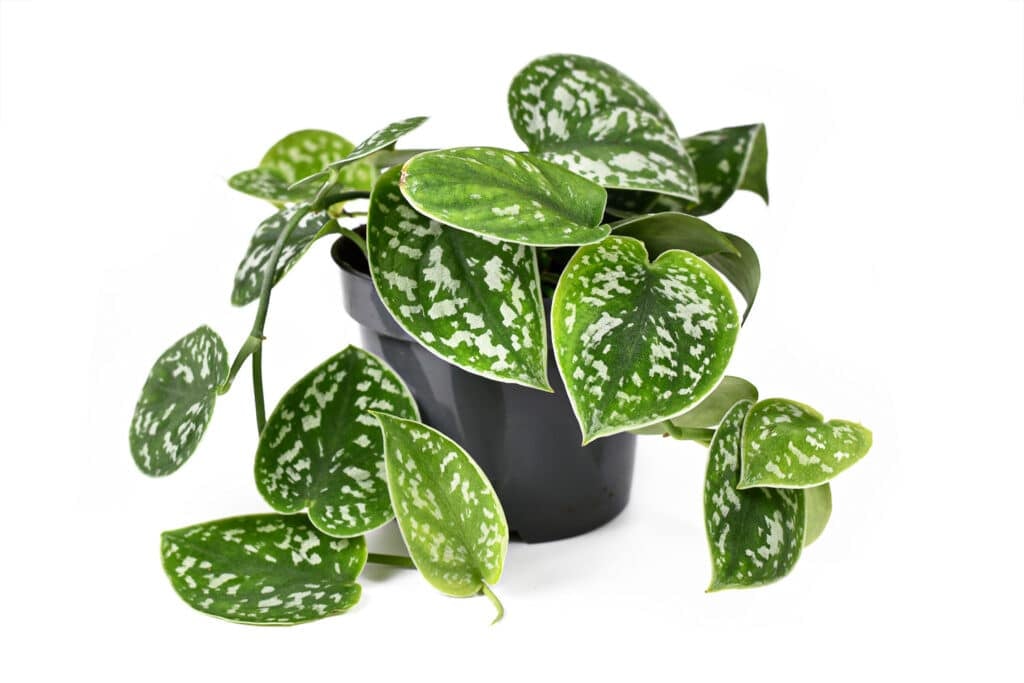
Satin Pothos, also known as Scindapsus pictus, is an excellent choice for indoor hanging plants due to its low maintenance and striking foliage. And although we’ve already listed a pothos, the satin pothos is worth listing as a seperate entry due to it’s unique appearance!
- Low Light Tolerance: This plant thrives in low light conditions. It can survive under fluorescent lighting, perfect for offices or apartments with limited sunlight exposure.
- Air Purification: Like other pothos varieties, the satin pothos effectively purifies the air by removing toxins such as formaldehyde and benzene.
- Variegated Leaves: The satin pothos’ heart-shaped leaves feature silver or metallic-like patterns on a deep green background. Its unique appearance adds visual interest to any room while requiring little effort to maintain.
- Versatile Growing Options: Besides being an attractive hanging plant, satin pothos can be trained to climb trellises or moss poles. This versatility allows for creative ways of incorporating it into interior decor schemes.
- Toxicity Warning: While satin pothos is generally safe around pets and children when placed out of reach, ingestion may cause mild irritation in the mouth and stomach. Therefore, caution should be exercised when locating this plant within homes.
12. Boston Fern
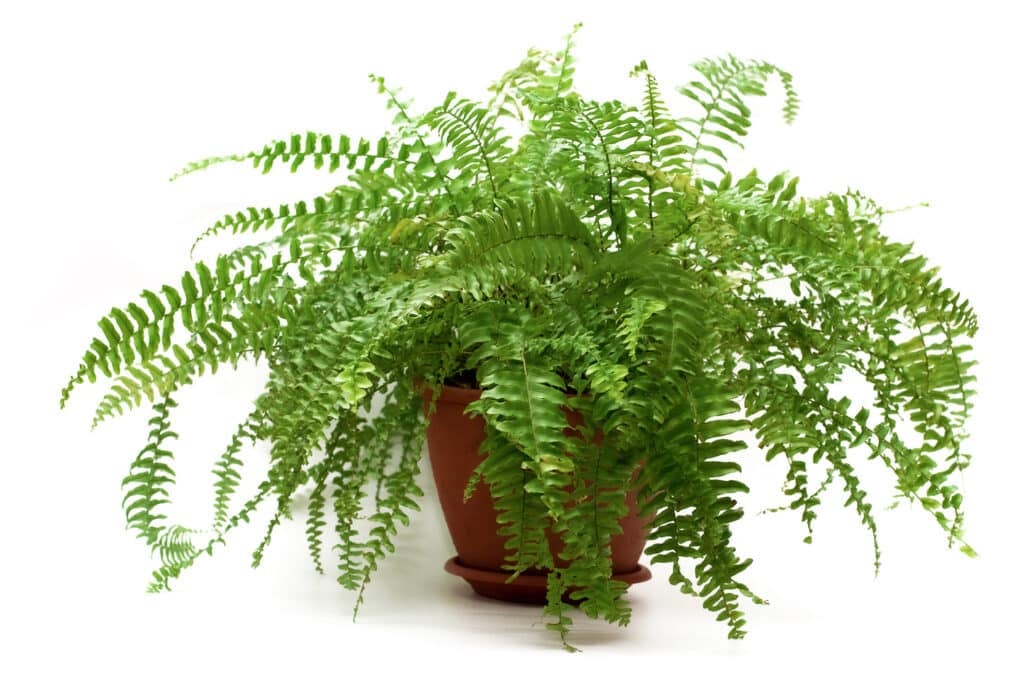
Boston ferns are popular indoor hanging plants due to their lush, feathery fronds and air-purifying qualities. Here’s why you should consider adding a Boston fern to your indoor plant collection:
- Air Purification: Boston ferns are known for their exceptional air-purifying properties. They can effectively remove toxins such as formaldehyde and xylene from the air, making them an excellent addition to any indoor space.
- Humidity Regulation: These plants thrive in humid environments, making them ideal for kitchen windows and bathrooms where moisture levels tend to be higher. Their presence can help maintain optimal humidity indoors.
- Low Maintenance: Despite their delicate appearance, Boston ferns are relatively low maintenance. They can flourish indoors without much fuss with adequate watering and indirect sunlight.
- Aesthetic Appeal: The lush green foliage of the Boston fern adds a touch of loveliness and tranquility to any room. Their graceful arching fronds make them visually appealing as hanging plants.
- Adaptability: While they prefer high humidity, these versatile plants can adapt well to various light conditions, including partial shade or indirect light.
13. Burro’s Tail
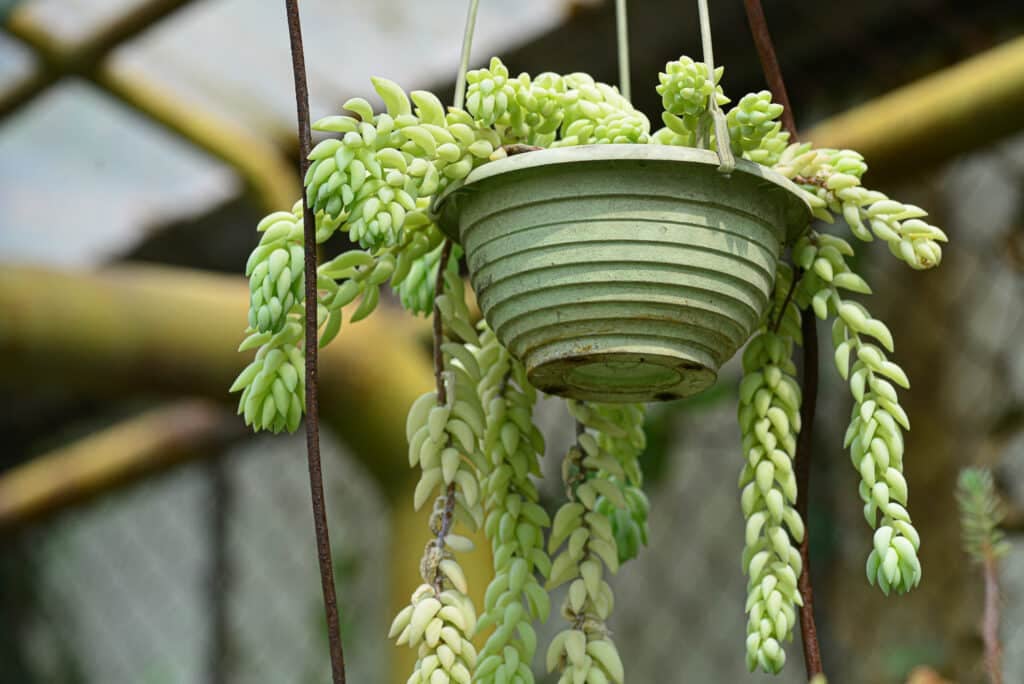
The Burro’s Tail, also known as Sedum morganianum, is a stunning trailing succulent that adds a touch of elegance to any indoor space.
- Low Maintenance: This plant doesn’t require frequent watering and can thrive in bright, indirect light.
- Unique Aesthetic: Its cascading stems with plump, teardrop-shaped leaves create a visually appealing display when hung from baskets or shelves.
- Drought Tolerance: The Burro’s Tail has adapted to store water in its fleshy leaves, making it highly tolerant to drought conditions.
- Propagation: It’s easy to propagate by planting fallen leaves or cuttings.
This plant has gained popularity on social media platforms like Instagram and Pinterest due to its photogenic nature and unique appearance. Many users love showcasing their hanging Burro’s Tail plants in various creative settings, such as macramé hangers or decorative pots.
14. Strawberry Begonia

Strawberry begonias, or strawberry geraniums, are charming trailing plants that add a whimsy to indoor spaces. There are countless types of begonias you could use for hanging indoor plants, but we chose the strawberry begonia for a number of reasons:
- Unique Appearance: Their delicate, heart-shaped leaves and runners producing tiny plantlets resembling strawberries make an enchanting addition to any room.
- Low Maintenance: These plants thrive in moderate light conditions and require minimal care and watering.
- Air Purification: Like many other houseplants, strawberry begonias improve air quality by removing environmental toxins and impurities.
- Propagation: They can be easily propagated by planting the small plantlets produced on their runners into new pots or containers.
15. Mistletoe Cactus
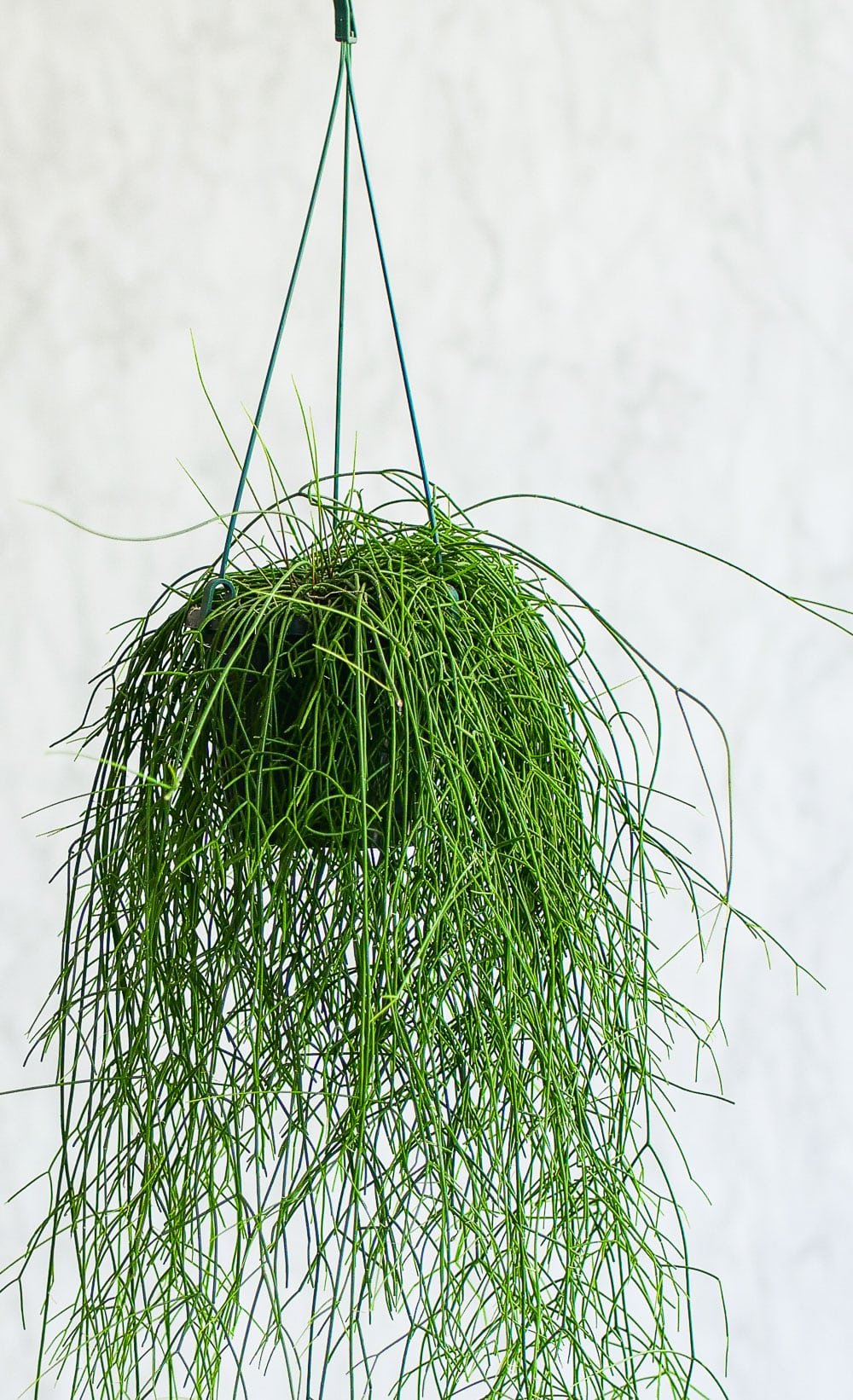
Rhipsalis, also known as mistletoe cactus, is an excellent choice for indoor hanging plants due to its unique appearance and low maintenance requirements. Here are some key insights about Rhipsalis:
- Adaptability: Rhipsalis is highly adaptable to various light conditions, making it suitable for indoor environments. It thrives in brighter indirect light but can tolerate lower light levels.
- Low Maintenance: This plant requires minimal care, making it ideal for busy individuals or those new to plant parenting. Infrequent watering and well-drained soil are essential for its health.
- Air Purification: Like many other houseplants, Rhipsalis contributes to indoor air purification by removing toxins and improving air quality.
- Aesthetic Appeal: With its cascading stems and delicate foliage, Rhipsalis has a very unique look and will be a conversation starter.
- Variety of Species: Numerous species of Rhipsalis are available, each with its own distinct characteristics. Some varieties have slender stems, while others feature more robust growth patterns.
16. Lipstick Plant

The lipstick plant, scientifically named Aeschynanthus radicans, is a beautiful hanging plant that bears bright red tubular flowers. Due to its easy care and suitability to grow in low-light conditions, it is an ideal option for indoor spaces that do not have a lot of natural light.
- Unique Blooms: The lip tick plant’s unique tubular flowers add color to any indoor space, making it a standout decorative piece.
- Low Maintenance: This plant requires minimal care, making it ideal for busy individuals or those new to gardening. The lipstick plant can flourish with occasional wat ring and moderate humidity levels.
- Indirect Light Preference: Unlike many other plants, the lipstick plant prefers indirect light rather than direct sunlight.
- Air-Purifying Qualities: Like most houseplants, the lipstick plant improves air quality by removing toxins such as formaldehyde from indoor spaces.
Lipstick plants are perfect for adding a touch of color and life to any room while requiring little effort in terms of upkeep. Their unique appearance and air-purifying properties make them an attractive option.
17. Maidenhair Fern

Maidenhair Fern is a delicate and elegant indoor hanging plant that brings a touch of nature to any space. Here are some key insights about this popular plant:
- Maintenance: Maidenhair Fern requires consistent moisture, ideal for bathrooms or kitchens with high humidity levels. However, avoiding direct sunlight is essential as it can scorch the delicate fronds.
- Air Purification: This fern purifies the air by removing toxins like formaldehyde and benzene. Its lush foliage not only adds aesthetic appeal but also contributes to creating a healthier indoor environment.
- Aesthetic Appeal: With its lacy, light green foliage, Maidenhair Fern adds a soft and graceful look to any room. Its airy appearance makes it an excellent choice for adding visual interest without overwhelming the space.
- Challenges: While beautiful, Maidenhair Fern can be demanding and sensitive to environmental changes. These plants require consistent care and attention to thrive indoors.
18. Wax Plants
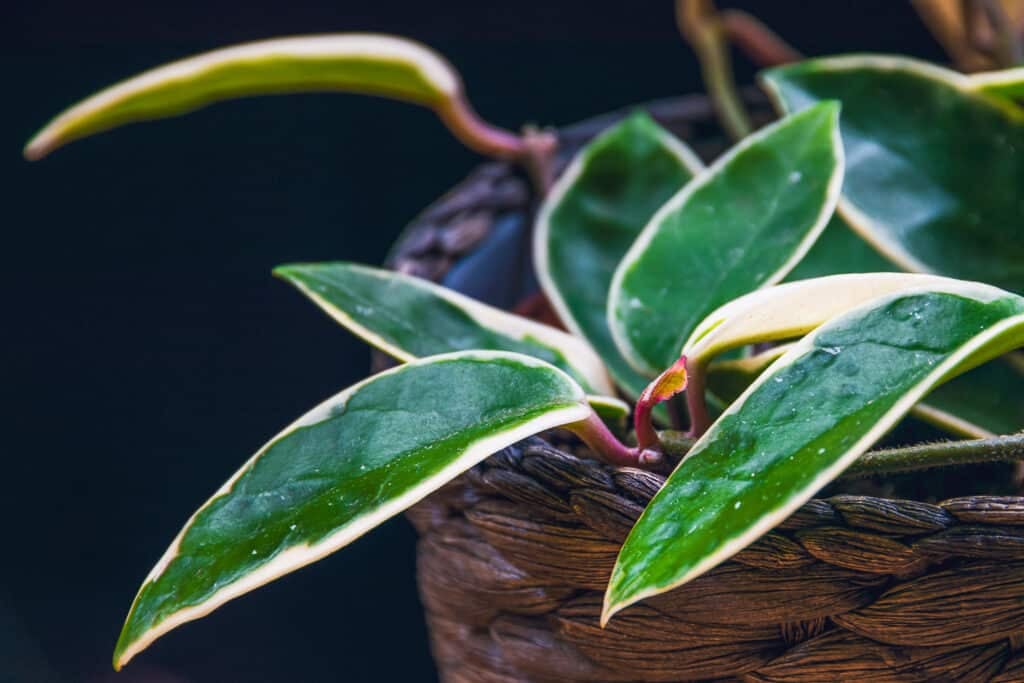
Hoya Carnosa, also known as the wax plant, is famous for indoor hanging plants due to its attractive waxy leaves and sweet-smelling flowers.
- Low Maintenance: This plant thrives in indirect sunlight and only requires watering when the soil is completely dry. It’s an excellent option for individuals with busy schedules or those new to caring for plants.
- Air-Purifying Qualities: Hoya Carnosa has been found to effectively remove pollutants such as formaldehyde from indoor air, contributing to better air quality in homes and offices.
- Longevity: This plant can live for many years with proper care, making it a sustainable addition to any indoor space.
- Aesthetic Appeal: The trailing vines of Hoya Carnosa create an elegant cascading effect that adds visual interest and charm to any room. Its unique star-shaped flowers further enhance its aesthetic appeal.
Expert Tips
- Choose low-maintenance indoor hanging plants like spider plants, pothos, or philodendrons to add greenery and freshness to any room without demanding too much attention.
- Consider each plant’s specific light and water requirements to ensure they thrive in their hanging environment. For example, spider plants and pothos prefer indirect light, while philodendrons can tolerate low-light conditions.
- Incorporate a variety of textures and colors by mixing different types of indoor hanging plants, such as the delicate trailing vines of a string of hearts or the unique round leaves of a string of pearls.
- Remember to regularly check the soil moisture and provide proper drainage for your hanging plants to prevent overwatering and root rot, ensuring their longevity and health.
- Be mindful of potential toxicity to pets and children when selecting indoor hanging plants, as some varieties, like English ivy and pothos, can be harmful if ingested.
- Use hanging planters with appropriate hooks and supports to securely display your indoor plants, taking into account their mature size and weight to prevent accidents or damage.
FAQ
The Spider Plant, Pothos, and English Ivy are great for low-light conditions. They can thrive in areas with minimal natural light, making them ideal for indoor spaces with limited sunlight.
It’s essential to check the soil moisture before watering. Generally, once a week is sufficient, but it may vary based on humidity and plant type. Overwatering can lead to root rot, so allow the soil to dry out slightly between watering.
Common issues include over and underwatering, inadequate lighting conditions, pest infestations such as spider mites or gnats, and improper drainage. You will want to regularly inspect your hanging plants for signs of these issues and adjust your care accordingly.
Spider Plant, Boston Fern, and Maidenhair Fern are pet-friendly options that add greenery without harming pets if ingested. However, it’s always advisable to research specific plant toxicity levels before introducing them into homes with pets.
Buy our organic Pest Management Book
$5.99
Our book is for you if you’re a home gardener passionate about growing healthy, pesticide-free plants! With over 100 pages of organic pest management information no bug will get in the way of a healthy plant again.

Final Remarks
Incorporating indoor hanging plants can significantly enhance the ambiance of any living space. With diverse options like Baby’s Tears, Spider Plant, Arrowhead Vine, and many more, individuals have ample choices to bring life and vibrancy into their homes. The featured plants add aesthetic appeal and improve air quality and overall well-being.
Related Posts
Editor’s note: This post was published on January 21, 2018 and updated on January 29th, 2024. The post now includes 15 additional recommendations.

Author: Laura Kennedy
Writer & Owner of Little Yellow Wheelbarrow










